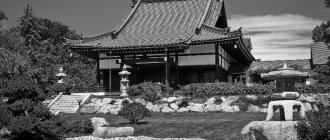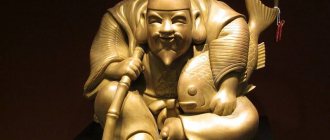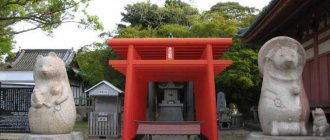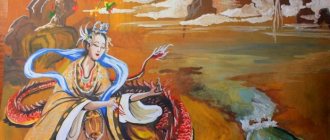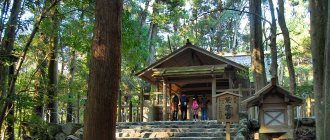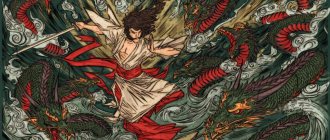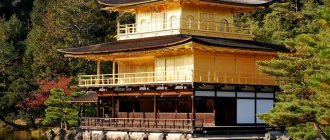Path of the Gods
Harmony between man and the surrounding nature is a central element of this belief. Evil spirits can disrupt this relationship. This is why they are banished or excluded through ritual.
Torii (Japanese 鳥居, lit. "bird's perch") - ritual gates
Thus, travelers can travel safely, and the sick are healed. Many local festivals in villages or urban areas have their origins in Shinto customs. For example, Shinto plays an important role in everyday life in Japan without being immediately seen as a religion.
Otabisho. Otabisho
Shinto has no founder and no scriptures such as sutras or the Bible. Propaganda and preaching are also not common because Shinto is deeply rooted in the Japanese people and traditions.
Unlike many monotheistic religions, Shinto has no absolutes. There is no absolute good and evil, and no one is perfect. Shinto is an optimistic Faith as people are believed to be fundamentally good and evil is believed to be caused by evil spirits. Therefore, the purpose of most Shinto rituals is to ward off evil spirits through purification, prayers, and offerings to the kami.
Way of the Gods - Shinto
The way of Japan has deep origins in Shintoism. The way of the gods (Shinto) is not so much a subject of worship as a way of life for the Japanese. “The term Shinto - in its broad meaning - covers the entire content of the most ancient era of Japan and at the same time serves as a designation of a unique cultural factor in Japanese history as a whole.” - wrote N.I. Conrad. The mind and heart of every Japanese, admits the Japanese professor Harada, is subconsciously imbued with Shintoism, regardless of the religion or ideology professed. That is why the alien teachings, be it Buddhism, Taoism or Confucianism, could not compete with him; rather, on the contrary, they themselves succumbed to his charm and acquired a Shinto tint.
According to Shinto ideas, the world is diverse and united at the same time, permeated with divine emanations. There is no impassable border between people and gods, between the living and the departed (we would say “to another world,” but for the Japanese there is no “other world”). “The visible and invisible worlds are forever connected by countless bonds of mutual necessity, and not a single relationship of this union can be violated without the most terrible consequences,” wrote the Russian Japanese scholar E.G. Spalvin.
The pattern was set by the gods, and one should not deviate from it so as not to violate their will. Japanese culture is directed not forward - towards renewal, expansion, but into the depths of centuries - to the origins. The law of recurrence made it possible not to interrupt the connection with the past, gave Japanese culture a continuous character, and determined the continuity of the reign commanded by the supreme goddess of the Sun - Amaterasu. The family of emperors, descendants of Amaterasu, could not disappear, just as the Sun and Moon cannot disappear, just as the connection between the Earth and Heaven cannot be interrupted. That is why they valued ancient texts and tried to prevent their distortion. "Kojiki" ("Records of Ancient Deeds") were conceived, as stated in the "Preface" of the scholar Yasumaro, in order to "eliminate errors and establish the truth, and so that it would be told to future posterity." Ancient texts containing information about the gods are sacred, they cannot be deviated from, they cannot be questioned, just as the decrees of the rulers of Japan were not questioned.
Japanese kami gods live everywhere: on Earth, in Heaven, in any phenomenon of Nature, but they are present invisibly. Therefore, it is not customary to talk about Shinto as a system of beliefs. This is precisely the Path that determined the life and culture of the Japanese.
Yasumaro introduces concepts that reflect the properties of the national character of the Japanese - their attitude to Performance as Creativity and the belief that work is sanctified by the gods. Every craft, be it weaving, planting and harvesting rice, making mirrors or building temples, has its own deity - the kami. This is the goal of the Path: man is called to embody the Spirit of Creation (Dzoka), to become Triune with Heaven and Earth.
Secondly, the Japanese believe that the world did not emerge from Chaos, but was manifested by the gods from the original mixture (according to Nihon Seki - from an egg), when this mixture had just begun to harden. The Forms and the Name had not yet been revealed, but the properties of Creativity and Execution had already made themselves felt. “The three deities initiated the creation,” the forces of Yin and Yang came into interaction and everything began to form.
Thirdly, the hieroglyph “creation” - Dzoka (zo/tsukuru - “to create”, ka/bakeru - “to be transformed”) means not so much the created world as the conceived world: what it should become according to Heavenly plan, that is, that perfect order , from which Genesis began and is approaching. In the Christian tradition, according to God's Providence, the Kingdom of Heaven is expected; in Buddhism - Nirvana, in Shinto - the world of the Heavenly Gods. Initially, God created everything well, but people remade everything in their own way, distorting the divine nature, and now they are paying for it.
Yasumaro, several centuries ago, assured that the Heavenly gods “pacified the whole of Heaven... and cleansed the whole earth.” Descendants only have to maintain order and cleanliness in temples, homes, in Nature, and most importantly in their own hearts, not forgetting the ritual of Purification. The Japanese dedicated not only rituals (matsuri), but also art to the purification and pacification of violent souls. There is nothing that is not subject to song, Tsurayuki assures: “Without any effort it moves heaven and earth, captivates even gods and demons invisible to our eyes, refines the union of men and women, softens the hearts of stern warriors.”
Let me remind you that civilizations following the Path are not subject to a break between the present and the past, or disruption of the natural rhythm - not only natural, but also human. In the Eastern understanding, everything seems to revolve in a circle, but, rotating in a circle, it ascends to the Highest - according to the law of the Path. The change of states in Nature (day-night, light-darkness, heat-cold, expansion-contraction) is not the Path itself, but its rhythm, the pulsation of the Path, is the key to life. All living things pulsate: inhale and exhale, ebb and flow, in order to avoid stagnation of blood, aging, not to disintegrate into separate parts, not to lose oneself. Everything originates and develops naturally, everything moves back and forth (Japanese jun-gyaku) weaving the pattern of the world fabric. If there were no Heavenly plan, there would be no Pattern.
And if it is Shinto that is called the Basis or “root” of Japanese culture, then it means that there is something in this Path that does not depend on time.” Is it because belief in kami is the purpose of the Japanese? Giving up your Path is the same as giving up your face, in general, life.
... the Japanese sought not so much to know the Truth, inaccessible to the human mind, but to experience it in ecstasy, in a heartfelt impulse. They communicated with the gods in a ritual dance - kagura or song - utpa, believing that an open heart is able to admire and through this learn what their divine ancestors want from people.
Heartfelt faith in the omnipresent kami saved the Japanese from desacralization of the world: the divine cannot be rationally explained, otherwise it ceases to be divine. Hence the desire to keep secret what was transmitted by the gods. The Japanese believe that the sacred Mirror, kept in the main Shinto shrine of Ise-jingu, in the pavilion of the Sun goddess Amaterasu (Naiku), which the goddess, along with a sword and jasper pendants (regalia of imperial power) transferred to the earth with her grandson Ninigi, acts invisibly. For many centuries, the Mirror has been kept in a cryptomerium cylinder above the sacred Middle Pillar (shin no mihasira). And not only is it impossible to see the Mirror, it is also impossible to enter the sanctuary; believers pray while remaining behind the sacred fence (himorogi).
It is not surprising that the rule of preserving “secret traditions” has also extended to fiction, which is associated with a special attitude towards sacred text and words. But not only. As a rule, knowledge of the “secret tradition” was passed on by inheritance, from father to son, by members of the clan - the custodian of the monument, or from teacher to student who had comprehended the hidden meaning.
“Secret traditions” have deep roots. Japanese culture can be called a “culture of legend,” coming from the “era of the gods.” Divine knowledge was transmitted from teacher to student, “from heart to heart,” which the Japanese called isin denshin. This is a Zen saying, but the idea existed and exists today. (The Japanese call their way of communication “minimum message communication”—over words.) Knowledge itself is sacred to the Japanese. Its reliable guardian is a pure heart, which will not distort or diminish tradition. The word, although it has a soul (kotodama), is only a help. That is why the Japanese tradition of transmitting knowledge “outside or above words” (gen-gai), outside the written text (furyu monji) is stable. We can talk about a culture of silence, pause, emptiness - so that one does not interfere with the other. The Japanese avoid verbosity, because any excess is contrary to the Way. It is not by chance that Japan is called a country where there is no arguing. This allowed her to save national energy and not waste it on empty troubles and showdowns.
In the most difficult times of internecine wars, the Japanese were never left with a sense of the supreme value of what was bequeathed by their ancestors. They could lift the siege of the castle if ancient manuscripts were kept in it. The Japanese tend to have a reverent attitude towards Culture in general. In Japan, for example, they carefully preserve ancient Chinese texts that were lost in China itself. They say that only in Japan does ancient gagaku music flourish, incorporating the musical traditions of various eastern peoples.
The path of the kami does not allow one to desecrate existence, distort the original Form, or cause damage to Nature - the Japanese call this tsumi or kegare - “pollution”, translated as “sin”.
A reverent attitude towards Nature gives rise to among the Japanese what is now called environmental consciousness. The measure of Truth is not the struggle between good and evil, which are conditional, dependent on accepted morality, but Beauty, independent of anything, unconditional, free. Evidence of this is the art of the Japanese: poetry, music, architecture, house design. And in everything - following the Path, which knows no stop, is not interrupted, flows freely, naturally. Hence the tendency towards asymmetry in the famous Japanese gardens, which do not hold the gaze on themselves, but lead into the invisible. Symmetry focuses on what is between two points. Japanese art does not erect boundaries; its goal is to move beyond the limits of the material world, to experience the reality of the eternally existing. All obstacles are conditional, but the Path leads to the unconditional - to Truth in the image of Beauty.
Art for the Japanese is the Path to the transformation of life through the experience of truly beautiful things. Truth is Beauty, Beauty is Truth. Beauty lies at the foundation of things, and therefore, following it, you follow a pre-established order. Nature itself is full of divine power, and if the master conveys this in his creation, then what he creates is full of divine power.
Is it not because Japanese art is not subject to the influence of time that it belongs not to itself, not to the will of man, but to what makes all hearts “one heart” (isshin)? “Can any of the people capture with a stroke of the brush or exhaust in words the Heavenly art of Creation?!” - Basho exclaims. The “true heart” (magokoro), which was revealed to the ancient emperors as “bright, pure, direct,” cannot lie!
Love for emptiness, unfilled space, and reticence is a characteristic of Japanese taste. Lack of freedom abhors the Path of the gods - without freedom, nothing will become itself. “One in everything, and all in One”: only by following their Path do they reach the One.
At the same time, in Japanese art, deviating from a rule is no less honorable than following it. The task is not to erect barriers between people and kami, man and Nature, between what was and what is. Yojo poetics (super-sense or feeling in its entirety) makes it possible to experience what is invisible. An unexpected image, a twist on a well-known theme, changes a familiar image. This is a kind of poetic acupuncture: finding that one point to set the energy of the heart in motion. Not deliberately, not intrusively (the true heart is free) - a hint gives rise to a response...
The Japanese believed that the human heart has four “Consistencies”: Justice and Compassion, Sincerity and Intelligence. The Russian scientist E. G. Spalvin, who studied the history of the Japanese people, wrote almost a century ago that man, according to Japanese views, is the son of Heaven and Earth. From Nature he receives a sacred feeling of compassion, and this feeling is what we call philanthropy. “He who, having been born a man,” says one Japanese teaching, “does not know the law of man, is not a man; Even if he was a man in appearance, in his heart he was the same as an animal.”
The cult of ancestors gave rise to three beliefs in Japan: the religion of the home - the household cult, the religion of the local deity or guardian god - the community cult, and the national religion - the state cult. The dead become gods, gaining supernatural power, but retain the character that distinguished them during life. According to Motoori Norinaga, it is necessary to appease the gods by offering food, playing the koto, playing the flute, singing and dancing and anything that can put them in a good mood.
According to the ancient texts Kojiki and Nihongi, Shinto gods are omniscient, creative, and irrational. The gods use their power not only for good: along with benevolent gods, there are also evil gods. However, evil gods can do good things, and good gods can do bad things. In general, the gods are just as unbalanced, unpredictable, and just as prone to anger as people. This is not surprising if the gods came from the same source as humans, animals and everything in the universe. And this source is the Holy Spirit of the God of Creation (Makoto Ueda calls Naobi no Mitama the Holy Spirit).
This is the essence: there is Something that stands above the countless gods, who themselves are the product of the eternal spiritual force. At the level of multitude, even hierarchical, there is no Truth, there is no Whole. This means that there is a certain highest point, a fixed Center, a vertical axis or a Heavenly rod. “Sacred pillar” - mihasira is both visible and invisible, which is why it is written differently: either as a “pillar” - the center of a Shinto shrine, or as a “pillar” - a spiritual symbol. This “core” keeps the hosts of gods and people and all things in balance. The Taoists say: “The wheel moves because the axis is motionless.” That is, we are dealing not with a horizontal, two-dimensional dimension, where there is no movement towards the Spirit, but with a vertical (three-dimensional) one, which, expanding the soul, changes the quality of life.
Norinaga insists on this: “If a person thinks that he can leave everything to the will of the gods and relieve himself of responsibility, then he is deeply mistaken. Everyone is responsible for what they do within their own boundaries.” The God of Creation has given everyone the opportunity to create according to free will; if a person does not do this, then he loses the God-given ability to do good and becomes like insects and birds. Our time is an example of how a person, fooled by the rational mind, does not feel the presence of the God of Creation above him and Naobi no Mitama within himself. By abandoning rational, didactic thinking, one can revive the originally truthful heart that Naobi no Mitama endowed a person.
Finally, only through literature can a person return to his true self, endowed with creative powers by the God of Creation. “Make it a rule to write poetry, read ancient stories, and you will recognize the poetic spirit of your ancestors.” A person who knows how to write good poetry and read high literature can, without even knowing it, cleanse himself of all the current rational thoughts that have suppressed his heart...
Literature makes it possible to communicate with Shinto gods, who are more similar to a true person than modern people. And Shinto, in turn, helps to understand literary work, which embraces all aspects of the mind, rational and irrational, consciousness and subconscious. “Unlike Confucianism and Buddhism, Shintoism does not engage in noisy debates about Good and Evil or Justice and Injustice” (Makoto Ueda). That is why literature allows us to return to the true humanity of the Path of the gods. Shinto is humane in its original views of the world and man; its cosmos is ruled by anthropomorphic gods. From them came people who would ultimately become gods... By reading the literature (of the ancients), a person learns about eternal feelings that are deeper than moral and rational teachings, and feels the charm of things (mono no aware). Thanks to literature, a person learns who he really is, what place he occupies in the world and what he should do in this life.
Indeed, the first three gods set the code for Japanese culture. They appear on their own, remaining invisible, on their own, one by one, disappear, having fulfilled their purpose. The First God personifies the spirit of the Center - absolute peace, balance. Outside the Center there is no Whole, outside the Whole there is no Truth. This Center, or the vertical axis connecting everything that exists on Earth with Heaven, is the axis that allows the whole not to fall apart and thereby directs it to spiritual fulfillment. Because the center is at rest, everything else arises naturally. The Sacred Center is the original, unchangeable, to which everything returns, approaching the Truth. “Having exhausted the primordial heart (honshin), you will comprehend the Truth,” says the Kojiki. The true or original heart is Enlightenment, the salvation of man.
To fulfill the will of the God of the Sacred Center, who is in motionlessness, and to complete Creation, the following two appeared. This is how the eternal connection between rest and movement, the Center (Unchangeable - fueki) and its implementation (Changable - ryuko) was realized. From here the law of recurrence naturally follows: not the creation of something new, but the fulfillment of what was commanded by the first gods. That is why it is so important for the Japanese not to break away from the Foundation, not to violate the divine plan.
In Japan, the Three Gods taught sacred knowledge. Yasumaro says about this: “When Creation (Ken) and Execution (Kon) first became distinguishable, the Three Deities appeared and initiated Creation (Zoka).” (Let me remind you: The three gods, who appeared one by one, personify the idea of the Trinity, a model of Life that is symbolic for Japanese thinking, a model of Life: a double helix rotates around a vertical axis.)
Three gods laid the foundation for Creation (Dzoka), while musubi means “producing soul” (tama). But the “Creative Spirit”, Dzoka, is not what is meant by Creation in Christian culture. The Creative Spirit gives life to that which exists unmanifestly and introduces it to the Path. Creativity is, first of all, a reciprocal process, the reciprocity of Earth and Heaven, master and deity. Every idea, every image comes from the world of the gods as a gift to man. If he is able to grasp them, then he becomes a creator. Creativity and Execution are twofold: only a true performer can be a creator, and vice versa.
For ten centuries, the idea of the Spirit of Creation (Dzoka) has essentially not changed, judging by Basho’s feeling: “Whoever follows the Creative Spirit (Dzoka) becomes a friend of the four seasons. Whatever he looks at, he sees a Flower. Whatever he thinks about, he thinks about the Moon. He who does not see the Flower in everything is a savage. He who does not have a Flower in his heart is like an animal. Cast out the savage, get rid of the animal, follow the Creative Spirit and you will return to Him.”
This is the credo of the Japanese master, and perhaps all Japanese masters, evidence of the “holistic” (zettai) character of Japanese culture, which has not lost the sense of the Unchangeable in the Changeable. This is the law that Japanese masters have followed at all times, which is why their art does not fade.
Shinto shrines
Shinto shrines are places of worship and homes for the kami. Most shrines regularly celebrate festivals (Matsuris) to expose the kami to the outside world. Shinto priests perform Shinto rituals and often live on the shrine grounds. Men and women can become priests and are allowed to marry and have children. The priests are assisted by young women (Miko) during rituals and at shrines. Miko wears a white kimono, is supposed to be unmarried, and is often the daughter of a priest.
Just as Buddhism has temples, Shinto has shrines, sometimes no bigger than a wooden box with a statue in it, somewhere on the side of the road. But also great gates (Torrii) such as Fushimi Inari-Taisha in Kyoto and Meiji Shrine in central Tokyo. Here you will find altars, buildings, ponds and gardens that are in harmony to worship the Path of the Gods.
Important features of Shinto art are temple architecture and the cultivation and preservation of ancient art forms such as Noh theatre, calligraphy, and court music (gagaku), an ancient dance music that originated in the courts of Tang China (618-907).
Chapter 5. Shintoism
Since the 6th century AD. e., when the Japanese government adopted the veneration of Buddha as a state ideology, Shintoism faded into the background. It did not disappear, but it was constantly in fierce competition with the new faith. At the same time, along with Buddhism, the influence of Taoism and Confucianism on the life of the Japanese was quite noticeable.
The state, while supporting Buddhism through administrative methods, at the same time sought to regulate the life of Shintoism and use it for its own purposes.
So, in the 7th century AD. e. the emperor assumed the title Akitsumami-amenoshita Shiroshimesu Yaiato no sumera-mikoto
(“Living Kami, Lord of the World and Emperor of the Yamato Kingdom”)256.
At the turn of the 7th-8th centuries, a special department was established - the Department of Shinto Affairs
. The heads of priestly clans entered his bureaucracy and thus received high-ranking privileges, while at the same time finding themselves under the control of state power.
Allowing Shintoism to exist within the country, the government for many centuries tried to the best of its ability to promote the establishment of Buddhism. One of the striking examples of this can be considered the publication in 685 of a special command: “... in every house a Buddhist altar should be built and an image of Buddha and Buddhist texts should be placed in it. At these altars worship should be performed with offerings of food."257
The degree of pressure on Shinto from authorities sympathetic to Buddhism varied. Nevertheless, the imperial house did not refuse the services of the national religion, which raised it directly to the supreme deity Amaterasu.
In the 12th century, the official monarch was actually removed from real governance. In practice, the shoguns
- heads of the most politically and militarily powerful clans. The shoguns supported Buddhism with even greater enthusiasm and zeal, seeing in it a religious tradition that was indifferent to the claims to divine honors of the emperor removed from the political arena.
This situation continued until 1868, when, after an era of conflicts and turmoil, Emperor Meiji
(1852–1912) managed to regain real power. The emperor undertook large-scale reforms in all spheres of life: economics, military affairs, administration, etc. Japan embarked on the path of assimilating the best achievements of European civilization, while simultaneously trying to rethink them in relation to its own history and culture258.
The necessary elevation of the emperor, who had regained real power and become the inspirer of reforms, was supposed to be achieved by returning him to divine dignity. For this purpose, Shintoism was returned to the status of the dominant religion, assigning it the role of the bearer of the ideology of national revival, transformation of the state and society.
At the same time, there is a growth in national self-awareness, which leads to strengthening of nationalist tendencies.
In foreign policy, these trends led to wars of conquest: the Japanese-Chinese (1894–1895) and Russian-Japanese (1904–1905), from which the Land of the Rising Sun emerged victorious. In 1910, Korea is annexed.
In 1914, the First World War begins, which Japan enters, being bound by an allied treaty with Great Britain. Taking advantage of the favorable situation, it occupies all territories previously controlled by Germany in China and the Pacific region. At the Versailles Conference, which summed up the results of the global international conflict, Japan participated as one of the victorious countries.
Victories on the battlefields inspired nationalist movements to new achievements. Throughout the country, persecution of people associated with a foreign culture or religious tradition began.
In the 30s of the 20th century, Japan lived under the influence of the ideas of militarism and nationalist chauvinism. The Second Sino-Japanese War takes place from 1937 to 1945. On December 7, 1941, the famous raid on Pearl Harbor was carried out, which actually became the beginning of an armed confrontation with the United States and Great Britain in the framework of World War II. At the same time, Hong Kong, the Philippines and the Malay Peninsula were conquered.
During the hostilities, everyone was amazed by the courage and self-sacrifice of Japanese soldiers, who were ready to give their lives not only in the name of achieving victory, but also in order to gain a tactical advantage during a military operation. Special suicide squads were created - kamikaze259
.
The most famous of them are pilots who were preparing to fly a single flight in order to bring their plane down on the enemy at the end of the mission. For this purpose, even special aircraft-shells were made, filled with explosives, the return of which to the air base was not initially intended.
There was a religious concept according to which Amaterasu assigned the pilots a special mission to protect Japan. The dead were glorified as heroes, declared kami
, temples were erected in their honor, and the families enjoyed great respect from their compatriots. There were many more young people willing to give their lives for the emperor and the country than there were aircraft suitable for this purpose.
On August 6 and 9, 1945, US aircraft carried out atomic bomb attacks on the cities of Hiroshima and Nagasaki. On August 9, the USSR enters the war with Japan. As a result of these events, on September 2, 1945, the Act of Unconditional Surrender of Japan was signed.
In December 1945, an order on religious associations was issued, giving religions freedom of action. Shinto was stripped of its privileged status as a national religion and ideology. Already in February 1946, Jinja honte
(lit. "Central Shrine Bureau") -
Association of Shinto Shrines
, uniting 80,000 of the 100,000 Shinto shrines. In 1947, Japan adopted a new secular constitution.
Today, the majority of the Japanese, although in practice they are not very religious people, at the same time consider themselves to belong simultaneously to the Buddhist and Shinto religious traditions. “Nowadays, a person gets married in a Shinto shrine, lives his life according to Confucian social precepts, adheres to some Taoist beliefs in “fortune” or “misfortune,” participates in folk festivals, and is buried in a Buddhist temple.”260
Shinto then and now
Shinto, "The Way of the Gods"
Several conflicts followed with the advent of Buddhism in the 6th century, but the two religions were soon able to coexist and even complement each other. Many Buddhists viewed kami as manifestations of the Buddha.
In addition to this practice, Shinto also developed as an organized religion; between 1868 and 1945 it was the state religion. Shinto priests became government officials, important shrines received government funding, Japan's creation myths were used to reinforce a national identity with the Emperor at its center, and efforts were made to separate and liberate Shinto from Buddhism. After World War II, Shinto and the state were separated.
People seek support from Shinto by praying at home altars or visiting shrines. A range of talismans are available at shrines for traffic safety, good health, business success, safe childbirth, good exam results, as guidance which means a lot in martial arts, and much more.
A large number of wedding ceremonies are held in the Shinto style. Death, however, is considered a source of impurity and is left to Buddhism. Consequently, there are virtually no Shinto cemeteries, and most funerals are conducted in the Buddhist style.
Confucianism
There are seven different types of Shinto shrines, namely imperial shrines, Inari shrines, Hachiman shrines, Tenjini shrines, Sengen shrines, and local shrines.
Purification pool next to a Shinto shrine.
What does a typical Shinto shrine ?
- Torris - Red gate that usually stands at the entrance or passageway to a Shinto shrine
- Komainu - A pair of guard dogs or lions guarding the entrance.
- Washing area - Before you can enter the temple, you must first rinse your hands and mouth.
- The main hall for offerings - "Sopaki", also called the main hall, and "Hayden" for offerings offer a price in the center of the temple.
- Ema - Visitors write their wishes here on wooden boards in the hope that they will come true. Usually it is about achieving success or the health of others
- Omikuji - Omikuji are future-predicting documents that can be drawn at random. They usually predict part of your future.
- Shimenawa is a rope with zigzag paper strips that represent a shrine. You'll usually find them near the entrances in the Torris area or on old trees or altars in towns.
Shinto shrines.
Views: 3,139
Share link:
- Tweet
- Share posts on Tumblr
- Telegram
- More
- by email
- Seal
Liked this:
Like
Gods of Ancient Japan
Deities of ancient Japanese mythology
Izanagi is the first god in Japanese mythology who had an appearance and was able to give birth to other gods. From the marriage of Izanagi and Izanami, the Japanese islands were born, and then the gods of the earth and roof, wind and sea, mountains and trees, plains and fogs, and others.
Kagutsuchi is the god of fire and volcanoes in ancient Japanese mythology. He caused the death of the goddess Izanami.
Kamimusubi is one of the first trinity of deities in Japanese mythology, appearing along with Ame no Minakanushi and Takamimusubi when the earth and sky separated.
Minakanushi or Ame no Minakanushi no kami, lord of the sacred center of heaven, in Japanese mythology the first of three deities who initiated creation.
O-kuninushi or U-keninushi no Kami, in Japanese mythology, the organizer of a prosperous life for people, a good ruler god. He is considered to be a descendant of Susanoo and Kushinada Hime.
Raijin is the god of lightning, thunder and storms. Raijin is usually depicted with a fierce and aggressive expression, standing on a cloud and beating drums with a tomoe symbol.
Ryujin is the dragon king, sea god, and lord of snakes in Japanese mythology. He was first mentioned in the legendary records of the Kojiki and Nihon Shoki under the name Watatsumi no kami.
Shichifukujin - in Japanese mythology, the seven gods of luck and happiness. Their names are Daikoku, Ebisu, Benten, Bishamon, Fukurokuju, Jurojin and Hotei.
Susanoo is in ancient Japanese mythology the lord of the deep sea, a deity born by Izanaki from drops of water that washed his nose during cleansing after returning from the kingdom of the dead.
Takamimusubi is one of the first deities in Japanese mythology, the god of high sacred creation, appearing on the sacred plain of the High Sky Takama no hara.
Takemikazuchi is a warrior deity with a sword in ancient Japanese mythology, possibly the embodiment of a sword. Appears in the myth about how the god Izanaki killed the fire god Kagutsuchi with a sword.
Tokotati or Ame no Tokotati no kami, in Japanese mythology, a solitary deity, one of the seven gods who first appeared in the universe, following Ame no Minakanushi.
Fugen Bosatsu is a bodhisattva in Japanese Buddhist mythology who embodies the spirit of enlightenment. Fugen Bosatsu was often depicted riding a white elephant.
Hachiman is the patron god of warriors in Japanese mythology. In the Middle Ages, Hachiman acted as the patron of samurai from the Minamoto clan, then as the protector of the samurai class, “the god of bow and arrow,” that is, as the god of war.
Hoori is a “fiery shadow”, a deity, the great-grandson of the sun goddess Amaterasu, the son of the god Hikoko no Ninigino Mikoto and his wife Konohana-sakuya-hime. Hoori was born in a chamber engulfed in flames.
Tsukuyomi in Japanese mythology and Shinto religion is the god of the moon and night, born from the water that washed his right eye Izanagi.
Emma-O is the ruler and judge of the dead in Japanese Buddhism. Emma-o ruled the underground hell of Jigoku; there he was surrounded by eighteen generals and thousands of warriors, as well as demons and horse-headed guards. The underworld was divided into eight fiery and eight icy hells.
Shinto: In the World of Japanese Spirits
Many people consider the Japanese to be Buddhists. There are indeed many Buddhists in the Land of the Rising Sun. But the traditional religion of Japan is Shintoism . This is a very ancient faith and completely open to all those interested. However, surprisingly little is known about it outside the islands.
The Japanese concept of “Shinto” can be translated into Russian as “the way of the gods.” This is the name of the traditional religion of this people. The Japanese believe that gods, like the souls of the dead, live everywhere. Only the material shell dies, but the souls remain and find refuge in natural objects or objects created by human hands.
The Japanese call these eternal souls of the world "kami". Kami can live in stones and trees, take possession of an entire grove or mountain, a waterfall or river, a sword, a mirror, a precious ring, a tablet with a sacred text... For us, the world is filled with “empty objects”; for the Japanese, all objects in the world around us are these are someone's souls.
Kami-kiri, also called kamikyu "Hair Thief".
Dispute between gods
According to traditional Japanese beliefs, our world was created in the following way. At first everything was in a state of chaos, and there was neither harmony nor beauty anywhere. But one day all the elements of the world began to gather in divine pairs.
Among the chaos, heaven and earth suddenly appeared - Takamanohara and the Akitsushima Islands (High Sky Plain and Dragonfly Islands). And then the first gods appeared. One such divine couple created the island of Onnogoro (the Middle Pillar of the Earth), and from their marriage many other islands and other kami were born.
Hyakkyagyou - "Parade of a Hundred Demons" An ancient legend says that every year Japanese supernatural creatures come out during the summer nights.
But nothing lasts forever, not even the gods. Having given birth to the fire god Katsuguchi, the goddess Izanami died and went to the Land of Darkness. Her husband Izanagi was grieving the death of his beloved and decided to take her away from death: he went to the underworld and found her decayed body. But the sight of this body frightened him so much that, sobbing, he returned to the ground and blocked the entrance to the dungeon with stones.
He himself went to perform ablution - he was so disgusted by the sight of decomposed flesh. While washing his face, he shook off the drops, and thus the gods began to be born. From the drop that washed his left eye, Amaterasu, the sun goddess, was born. From the drop that washed her nose is her brother Susanoo, the god of the wind. And many others.
The goddess Izanami, who resides in the world of the dead, became angry and promised to kill the people he had created in revenge for her husband’s cowardice, and her husband promised her to build more and more huts and populate them with people. So they began to compete with each other: Izanami kills people, and Izanagi produces new ones. There was also enmity between Amaterasu and Susanoo. The brother once burst into Amaterasu’s chambers and scared her so much that her sister took refuge in a cave.
It became dark on earth, eternal night came. Only with a concerted effort did the gods persuade Amaterasu to look out of hiding. And then the clear sunny day returned again. And the obstinate Susanoo was driven out of sight so as not to frighten his sister. The Japanese believe that Amaterasu became the ancestor of the imperial family.
The goddess's grandson, whose name was Ninigi, descended to the Japanese islands to rule the people. And a descendant of Niniga named Jimmu became the first emperor of Japan. According to tradition, it is believed that Jimmu founded the state in 660 BC.
From generation to generation, the Japanese passed on a sacred object: the mirror of the goddess Amaterasu, which is considered a symbol of imperial power. As they believe on the islands, the sacred mirror is still kept in one of the three imperial temples. After all, according to Japanese beliefs, the emperor is not the deputy of God on earth, as Europeans believed, but he himself is a deity. It was only after World War II that Japanese emperors agreed to no longer call themselves gods.
Life without suffering
While Christians have an established creed, the Japanese do not have rigid dogmas. They simply know that initially the world is good, and evil comes into it when people lose their purity and stop listening to their own soul. Good and evil as separate concepts do not exist at all. Evil, by and large, is just a “disease,” and a person who is greedy or cruel is sick. If he can restore the original purity of his soul, he will recover. There are many myths and legends on this topic.
Sometimes insight comes under the influence of sleep. Sometimes a person suddenly hears the voice of a kami, which guides him on the right path. And sometimes he himself understands his mistakes and vows to correct them. The Japanese do not know any punishment after death, like Christians. But evil souls, after the death of their owners, can become evil spirits and frighten good people, even appearing to them in the form of ghosts.
The Japanese consider illness and death to be undesirable for their kami: it was not for nothing that Izanagi fled from the decomposed body of his wife. It is forbidden to enter temples with bleeding wounds or if a person has lost bodily integrity and purity due to illness. Inside Shinto shrines you will not see the graves of righteous people and heroes, as is customary in Christian culture. Burying someone inside a temple is the same as making the temple a haven for evil. Temples should give peace and peace of mind, and not remind us of suffering and death.
To live virtuously and honor the gods and ancestors, the Japanese build Shinto temples, which consist of two parts. The first part is the honden, where the altar is located and the sacred object, which is possessed by the spirit of the kami, is kept. The second is haiden, a room for believers. Sometimes both halls are connected into one. Sometimes the honden is located directly in the open air, and the altar is a stone or mountain. The temple may look like a rectangular area with two pillars - gates without doors, called torii.
The services are led by a kannushi dressed in a white kimono, matching pants and a black cap. Sometimes his assistants, miko, take part in them. In temples, the Japanese perform four Shinto rituals - symbolic purification (harai), offering to the gods (shinsen), ritual prayers (norito), ritual feast (naorai). Harai involves washing the mouth, hands and face with temple water. Any gifts to the gods can be used as shinsen - food, objects dear to the heart, sacred texts, money.
Prayers are usually read by clergy and accompanied by other rituals, and all the parishioners gather for a ritual feast. They eat and drink some of the offerings to their kami, sharing a ritual meal with the spirits. Some prefer to pray to the kami alone. For the uninitiated, it looks strange - a person stands in complete silence, sometimes spreading his arms wide and clapping his hands forcefully. The Japanese believe that by clapping they attract the kami's attention to their prayer.
In addition to temples, the Japanese pray at home altars, which often look like a simple shelf on which sacred objects are placed. A couple of times a year, Shinto shrines celebrate major holidays that are either related to the history of a particular temple or are dedicated to the deity that protects it.
Kami named Christ
Shintoism originated in the distant past of Japan and permeates all Japanese culture. At the same time, this religion is very tolerant of other beliefs, therefore it has absorbed, for example, features of Buddhism. You can often see images of Buddhas in Shinto shrines. There may even be Buddhist sutras read and Buddhist symbols used.
At one time, Japanese Shintoism was so closely intertwined with Buddhism that even Shinto Buddhist temples appeared. And only a special decree of the emperor stopped this fusion. In some areas, Shintoism is intertwined with Confucianism.
The only “imported” religion that failed to intertwine with Shintoism is Christianity. And not at all because the Shintoists were not ready to introduce the European Christ into their pantheon. Jesus seemed to the Japanese to be an excellent kami, and they were ready to worship him. But the Christians were outraged. They demanded that the Japanese recognize the exclusivity of Christ and their kami as harmful spirits. The Japanese did not agree to this.
The funny thing is that the Japanese themselves consider Shinto not a religious doctrine, but the cultural characteristics of their homeland. Even the name of Japan - the Land of the Rising Sun - is associated with the Shinto goddess Amaterasu. Religious and cultural layers in the consciousness of the Japanese are so closely connected that they cannot be separated. This amazing unity gave rise to a special Japanese way of thought and life, which seems completely incomprehensible and very attractive to foreigners.
Nikolay KOTOMKIN
